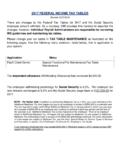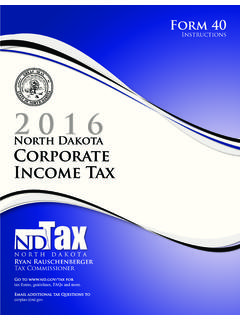Transcription of State income and franchise tax quarterly update - EY
1 First quarter 2014. State income tax developments State income and franchise tax quarterly update First-quarter 2014 State tax developments The following provides a summary of the legislative, administrative and judicial State income and franchise tax updates that occurred during the rst quarter of 2014. Key developments New York enacts budget bill containing significant corporate tax reform On 31 March 2014, Governor Andrew Cuomo signed the scal year 2014-15 budget bill (A. 8559D/S. 6359D), which includes signi cant corporate tax reform. The most notable changes are as follows: Repeal the existing bank franchise tax and merge it into a substantially modi ed general corporation franchise tax Reduce the general corporation franchise tax rate from to (beginning in 2016). Adopt a bright-line, economic presence nexus standard ($1 million of New York receipts.)
2 Applicable to all businesses in New York). Change the computation of New York State 's net operating losses (NOL) from a pre- apportioned NOL to a post-apportioned NOL, and provide an NOL conversion subtraction for NOLs carried over from periods prior to enactment of the new NOL rules, subject to limitations Adopt a single receipts factor for all New York taxpayers (not previously available to Article 32 taxpayers, , banks and nancial institutions). Modify combined reporting rules, adopting mandatory water's edge unitary combined ling Adjust the way in which sales are sourced to New York for factor apportionment purposes to provide for customer sourcing ( , to the State where the bene t is received) and to provide for a speci c election for franchise tax, has not yet adopted parent/subsidiary liquidations).
3 income from quali ed nancial similar changes, although city (3) adding redemption as a instruments of cials have indicated that they are disposition triggering DISA gain considering proposing adoption of recognition; (4) ability to cure . Eliminate the current subsidiary many of the key provisions of the a DISA with a subsequent capital capital and related franchise tax State tax reform for city purposes. In contribution (similar to the provisions, including the additional the meantime, an extension of the mechanisms to eliminate an excess modi cation for expenses directly/. Gramm-Leach-Bliley Act transition loss account (ELA) under the federal indirectly attributable to subsidiary provisions currently in the New York consolidated return regulations). capital (with substantial modi cations City Administrative Code, are contained to the de nitions and treatment of Amends the simplifying rules to in the budget bill.)
4 Investment income and capital) prevent potential sales factor dilution that resulted from tracking Increase New York State 's California revised intercompany intercompany transactions on a Metropolitan Transportation Business transaction regulations approved separate-company basis Tax Surcharge rate On 8 January 2014, the California The changes are effective 1 April 2014. Phase out the capital base tax Of ce of Administrative Law (OAL) and will apply to all intercompany through 2020. approved amendments to California's transactions occurring on or after Reduce the tax rate on the business intercompany transaction regulation, 1 January 2001 ( , retroactively income base for all quali ed Cal. Code Regs. titl. 18, section to the effective date of the original New York manufacturers to 0% Key changes include: regulation), although taxpayers may These corporate income and franchise Rolling forward the conformity elect to have amendments related to tax changes are effective for tax years date to the regulation's federal existing DISAs apply prospectively as beginning on or after 1 January 2015, counterpart to 1 April 2012 (formerly of the effective date of the changes.
5 With certain notable exceptions. For a 17 March 1997), thus conforming to For an in-depth discussion of these more in-depth discussion of these many federal relaxed provisions related to changes, see Tax Alert 2014-129, signi cant changes to New York State 's intercompany debt dated 20 January 2014. corporate tax system, see Tax Alert Ernst & Young LLP's take: These Signi cant changes to the deferred 2014-655. amendments should be welcomed by intercompany stock account (DISA). Ernst & Young LLP's take: These 1. provisions, including: (1) tiered most taxpayers and come after years legislative changes will dramatically distribution relief ( , DISA reduced of collaboration by the franchise Tax change New York's business tax by subsequent capital contributions, Board (FTB) and taxpayers. Taxpayers system and affect a variety of New annual DISA reporting requirements that bene t from the amendments to York taxpayers.
6 They will be generally expanded to include DISA balances the California regulations may revise effective in 2015; however, some reduced or eliminated by capital their DISA computations to re ect provisions take effect in 2014 or are contributions); (2) guidance for the regulatory changes. Speci cally, delayed until 2016 and later years. merger and acquisition (M&A) taxpayers that are part of a combined Corporations need to consider the transactions, explaining that the reporting group that reported DISAs effect of the changes brought about by merger of combined group members related to merger transactions should the budget bill on their quarterly State does not trigger DISA recognition if review or recalculate the DISA balance tax provisions. a majority of shares are owned by related to the surviving member's other members of the group ( , stock to make sure it conforms to the Further, New York City, which imposes DISA rules as amended.
7 Due to the DISA is not triggered for brother/. a separate general corporations tax retroactive effect of the amended sister mergers but is triggered modeled on the New York corporate regulations, taxpayers that reported for redemptions or liquidations or 2 State income / franchise tax quarterly update a DISA that had been triggered and of Treasury (the Comptroller) had the should be subject to tax in the State . on which a gain was reported and authority to impose corporate income Businesses that have intellectual subject to tax, should consider ling an tax on both an out-of- State subsidiary property holding companies, nance amended return and claim for refund. that held patents as well as an out-of- companies or other similar businesses State nancing subsidiary (collectively in their organizational structure and are Unless electing to apply the subsidiaries), because the subsidiaries not ling returns in Maryland should amendments prospectively, taxpayers had no real economic substance as consider the impact of the ruling in this should correct their DISA balances for separate business entities from their case on their particular circumstances, capital contributions made after the parent, a multistate manufacturing notably because if such entities have creation of the DISA.
8 The amendments not led returns with Maryland, it is addressing subsequent capital the Comptroller's view that the statute contributions provide for recalculation After concluding that both of the of limitations with respect to such of a DISA for capital contributions made subsidiaries had nexus with the State entities remains open inde nitely, and since 2001. If a taxpayer had reported on an agency nexus theory through statutory interest at the rate of 13% will a gain or income from a triggered the parent's activities in the State , the apply to any con rmed assessments. DISA that can be reduced under the Court upheld the Comptroller's use of new capital contribution adjustments, the parent's Maryland apportionment refund claims should be considered if factor to compute the subsidiaries'. the statute of limitations is open.
9 If the Other noteworthy State tax obligations in lieu of the statute of limitations is closed for the statutory two-factor (property and developments taxable year the DISA was triggered, payroll) standard applicable to Legislative a taxpayer should keep track of the intangible holding companies, which overstated DISA gain or income as a would have resulted in no apportioned Idaho: Legislation (HB 402) enacted potential offset item during the course income to the State . on 13 March 2014, modi es Idaho's of a California FTB audit. Ernst & Young LLP's take: Although income tax provisions to provide Also, taxpayers should consider making a taxpayer loss, the Court's ruling at guidance for calculating NOLs when future capital contributions to reduce least clari es what it rst said in its taxable income is determined by an existing DISA balance.
10 Regardless, 3. 2003 ruling in SYL with respect to excess inclusion income , as determined even though the new California Maryland's view of nexus: there is no by Internal Revenue Code (IRC). regulations provide for a cure to a unitary nexus principle in Maryland. section 860E (which deals with the DISA balance similar to that provided Instead, once nding limited economic treatment of income in excess of for an ELA, the impact can be very substance, the Court will apply an daily accruals on residual interests different and taxpayers should carefully agency nexus rule to determine in a real estate mortgage investment consider the California consequences whether an out-of- State subsidiary is conduit). Provisions of HB 402 also of implementing any DISA cure. subject to Maryland taxation. amend combined reporting rules to include a new provision addressing Once nexus is determined in this way, excess inclusion income and NOL.














